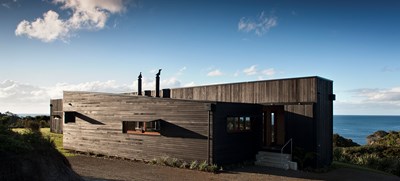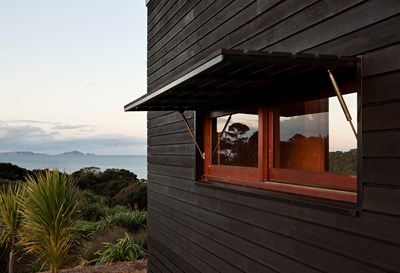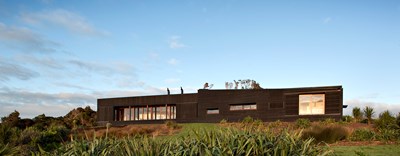Quest for a sense of place
Tutukaka Beach house, a New Zealand Architecture Awards winner in 2012, was designed by Crosson Clarke Carnachan Architects
Photo by Simon Devitt
Architect Paul Clarke discusses the process of designing, one that should be enjoyable and engaging for both you and your architect.
Quality design is more than simply the way spaces relate to one another or the result of making spatial and material decisions. An architect will respond to your specific needs using creativity and instinct informed by knowledge and experience, going beyond the sum of these parts to satisfy your dreams and aspirations.
Co-develop the design brief
At the early conceptual stage, you should aim to provide or co-develop a detailed brief along with your architect. This can come in many forms. It could be made up of a series of desired spaces or experiences, a set of visual references. Or it could be a comprehensive list, a poem or story. Next, working within a set of parameters covering the brief and budget as well as any site constraints, your architects and builders will seek to fulfill this through an ongoing, iterative process that meets and exceeds your expectations.
Creating a sense of place
Architecture should contribute positively to its environment, whether through assimilation or juxtaposition, or somewhere in between. The relationship between a building and its context is crucial to the success of architecture.
Frank Lloyd Wright said, “No house should ever be on a hill or on anything. It should be of the hill. Belonging to it.”
It is equally true to say that any house, whether located on a hillside or not, should be ‘of its site and its context’. This in turn requires a thorough understanding of the proposed site.
In the early stage of the design process, many architects will spend as much time as possible on your site. This enables them to get a more heightened sense of the place together with a greater understanding of the physical conditions. Orientation to the sun is key. There will be views that need to be framed, prevailing winds to be protected against, neighbours to be respected and outdoor spaces you will want to enjoy.
Another aspect to be fed into the early process is the ‘bigger picture’. What is the history or cultural significance of the site, the town and even the wider region? Sometimes this will spark an idea that can become an underlying design concept.
Beyond these more practical considerations, the design could be influenced by historical, family and cultural connections. It may be connected to a desired lifestyle — a passion for the ocean, lakes, mountains or rivers, suburban or urban contexts — all of these can have an influence.
If these references lead you to a more personal connection with the project, it’s likely the process of creating your new home will be a far more enriching experience.
The architect’s challenge is to create new forms of expression that capture both the users and the observers. This allows the built form to express meaning and provide ownership. You will experience a sense of belonging and, ultimately, delight by living in and using the property.
Expressing the abstract
Exploring the design idea leads to consideration of materials, proportion and the effect of light, space, volume and texture. Both as an object and something meaningfully integrated into its landscape, the built form results in experiences and memories that give rise to delight.
Contemporary art is often a reinterpreted expression of the abstract in colour, form and meaning. Similarly, contemporary architecture allows for this reinterpretation to be explored by restraining the conventions of traditional built forms, then reconsidering them in ways that allow new styles of building to arise. Ideally these re-expressions of the built form also constitute a new art form.
This could be derived from the locality, based on local building types or the site. Alternatively it could spring from an idea meaningful to a place, something in the history or a passion that you or somebody in your family has — perhaps a connection to work, the family or a hobby. In any event, form provides what architects term ‘an expression of space’. The totality is a manipulation of:
Shape, materials and texture.
Rhythm, proportion and volume.
Solidity, openness and void.
Colour, light and dark.
Enclosure, exposure and security.
Materiality
This refers to the applied use of various materials in the construction of a building. The importance of materiality runs parallel with space and form. The choice and eventual selection of materials can fundamentally change the feeling and mood of a building. This is where we determine what you see, touch and feel; how you interact with the building. Perhaps more than any other aspect, materiality is what consciously influences our connection to a building or a space.
By comparison, the more ‘conceptual’ aspect of architecture is harder to define. Ultimately where the material and the conceptual intersect is the place where successful architecture is born. Material surfaces activate the senses and so form our experiences. We ‘receive’ these experiences through a combination of sight, sound, smell and touch. A ‘live’ space with many hard surfaces provides a different experience to exactly the same form but with carpeted or upholstered surfaces.
This manipulation goes well beyond the selection of timber versus concrete or paint versus wallpaper. Material selections will evoke different responses from each occupant of a building. These will interweave with formal and spatial cues, resulting in that unique moment of architectural experience.
 This article first appeared in Design Guide, a resource written by architects and designers for those thinking about undertaking a new house or renovation project.
This article first appeared in Design Guide, a resource written by architects and designers for those thinking about undertaking a new house or renovation project.








